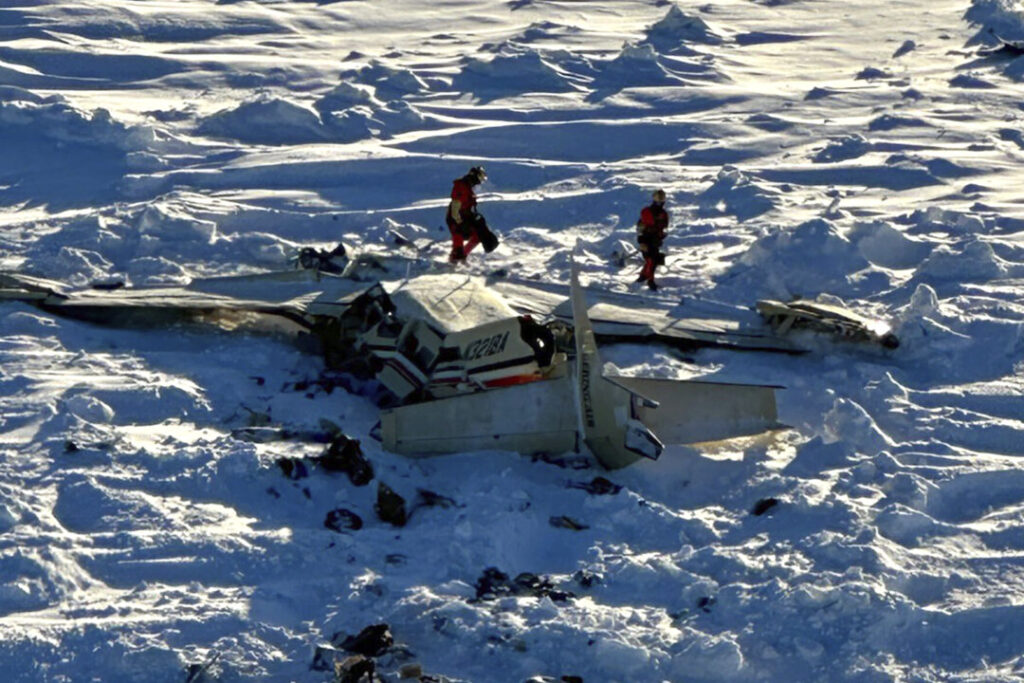The National Transportation Safety Board has issued a preliminary report on the crash of the Bering Air Flight 445.
The National Transportation Safety Board (NTSB) issued a preliminary report on a plane that crashed in Alaska last month, finding it to be too heavy for weather conditions.
The Bering Air single-engine plane collided with sea ice on February 6th, killing all 10 people on board.
The initial findings included that the commuter plane was too heavy for the icy conditions at the speed and altitude that it was flying in.
“Information on cargo and overweight status is part of an ongoing investigation that is expected to be completed in 12-24 months,” NTSB spokesman Peter C. Knudson told NTD, sister media of the Epoch Times.
Federal agents determined that the estimated total weight of the plane is about 9,865 pounds with all its contents departing, which is 1,058 pounds above the flight limit if the forecast has ice-like weather conditions.
The final report has not been published yet.
Pilot Chad Antill of Ames, Iowa, held a commercial pilot certificate, accumulated about 2,500 hours of flight time, flying about 58.4 hours within the previous 30 days and 4.4 hours in the previous 7 days.
Bering Air did not respond to requests for comment at each publishing time.
At the time of the crash, Bering Air Operations Director David Olson said airport officials had lost contact with the regularly scheduled afternoon aircraft within an hour of takeoff.
NTD learned that the Autopilot was released on the Bering Air Flight 445 when the airspeed of the plane dropped to 99 knots.
“After about 19 seconds, the airspeed was reduced to about 70 knots, the altitude was about 3,100 feet MSL, and the end of the data available from onboard avionics,” the first report read. “In the meantime, the plane changed from the west course to the south.”
The Turboprop had traveled only 150 miles between the Unalakleet and the Nome community when about 30 miles southeast of the Gnome went missing. Radar data shows it is the last visible at 3,400 feet.
“No emergency locator transmitter (ELT) signal was detected from the plane after the accident,” it read. “However, scene inspections determined that the ELT had been disconnected from the antenna during the impact sequence.”
The remains of Cessna Caravan were discovered the following day in large, drifting pieces of floating ice, after extensive searches. It was revealed that nine passengers along with the pilot had died.
“When the portable Elt antenna was installed, we heard a strong signal from the handheld receiver,” the investigator wrote. “Detailed follow-up aircraft, engine and propeller testing is pending.”
According to the report, following the review of the plane logs, two defects in the plane were addressed prior to departure.
US civil aviation patrol radar data show that the plane has lost elevation and speed quickly, but the US Coast Guard says no distress signals have been sent from the Freefalling aircraft.
“The plane was flying in areas where moderate icing was possible between 2,000 and 8,000 feet and could be dangerous for aircraft with light weather,” NTSB chairman Jennifer Homeding said at a press conference held at Gnome last month.
Homedy added that the aircraft equipment was evaluated as part of the investigation and that there is a prevention system on the wings and tail.
The Associated Press contributed to this report.



